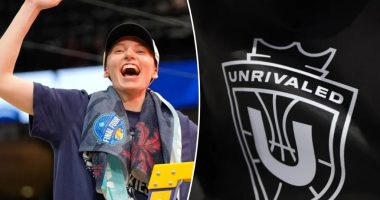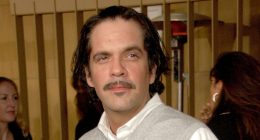What do you see when you read Pete Alonso’s reaction to trade rumors with his name at the center?
Here is a 28-year-old star, the best hitter on the Mets and the face of the franchise, saying he wants to continue on as long as the team will have him.
“I love representing this organization, I love being a Met,” Alonso told reporters in Atlanta on Tuesday night. “I love representing the City of New York the best way I possibly can.”
That came in response to a report from The Athletic’s Ken Rosenthal that the Brewers and Mets were within “field-goal range” of a trade to send Alonso to Milwaukee at the deadline.
And it came in the greater context of the Mets undergoing a sell-off which will see them aim to compete for a title again in two or three years — when Alonso is 30 or 31 years of age.
So here is the sort of strange situation that the norms of modern baseball dictate the Mets are in: They have a superstar in his prime who wants nothing more than to play for them. And yet conventional wisdom is that they should probably trade him before the end of the 2024 season, when he is set to reach free agency.

How depressing is that?
It is, by the way, pretty hard to argue that the Mets have done anything even close to maximizing what analytics say should be Alonso’s prime. He has hit 185 home runs and appeared in three All-Star games for the Mets, but played in just three postseason games, none past the wild-card round. This is his fifth year in the league.
It is as if, after the 2009 Mets fell apart due a mess of injuries and underperformance similar to what has transpired in 2023, they considered trading David Wright to Cleveland. At the time, that would have been an unthinkable scenario.
Now, Alonso wanting to stay represents a litmus test, both for fans and for the organization at large. Is it unthinkable to cut bait on a young face of the franchise so soon, or unthinkable to sign a contract that might look bad three years down the line?
Further contributing to the divide is that what you make of Alonso’s season depends — a lot — on which numbers you value.
After an 0-for-4 in Wednesday night’s 7-0 loss to the Braves, his batting average (.222) is down nearly 50 points from a .271 mark last season, and he is striking out more.
But his .848 OPS is within range of an .869 mark last season, and with 39 home runs, he should easily surpass 40 — his third career 40-homer season would match the total of everyone else in Mets history.
His average exit velocity was exactly the same as in 2022; he was barreling the ball more often and hitting it hard less often.

Baseball-Reference WAR has him on pace for a similar, perhaps slightly lower (3.7), output than last season (4.4). Ditto for Fangraphs (3.7 vs. 4.0). By the advanced numbers, he is not having as good a year as he did in 2022, but the decline is far more subtle than batting average would have you believe — perhaps even within the range of a rounding error.
He probably won’t fall off a cliff in 2024. But if the Mets re-sign him in 2025, they won’t be getting his best years.
What they would be getting is a veteran player who has represented the team loudly and proudly. Maybe someone who can ensure No. 20 is next to No. 5 in the outfield at Citi Field one day. (Wright doesn’t yet have that honor, but there’s not much of an argument that he shouldn’t.)
“I don’t know what the future holds, but right now I’m a Met and I love being a Met,” Alonso told reporters. “I take pride in putting on a Met jersey every day and representing the City of New York.”
Is that enough for you?
A Yankees ‘disaster’ flick
Maybe Brian Cashman should shred the Yankees every day.
Hours after their GM conducted a press conference to admit the season had turned into a “disaster,” the Yankees went out and snapped a historic nine-game losing streak with an emphatic 9-1 win over the Nationals in The Bronx.
And all it took was Aaron Judge blasting three home runs and Luis Severino jumping into a time machine.

Cashman had set heads nodding across Yankees fandom when he said he was “embarrassed” and delivered the eulogy on a season that is rumored to have 36 games remaining.
“I think it’s all gonna be evaluated,’’ Cashman said. “We’ll look at every aspect of the operation. It takes us where it takes us. Stay tuned. We’ll all be evaluated, including myself. … Unfortunately, we’re gonna have some time to do that.”
The job statuses of Cashman and manager Aaron Boone are the most pressing questions. As The Post’s Joel Sherman writes, the autopsy must be thorough.
“[Hal] Steinbrenner is going to have to ask hard questions and hold Cashman to hard answers that don’t just blame misfortune or whatever the GM views as bull,” he wrote. “This can’t just be mild touch-ups, promises of better injury results next year and see everyone in Tampa for pitchers and catchers come February.”
Read Related Also: Russell Island fire: Annastacia Palaszczuk sparks debate over special boat trip to the scene of the tragedy where five children and an adult died
— Jonathan Lehman
Today’s back page

Read more:
⚾ Shohei Ohtani will not pitch for rest of season after suffering UCL tear
🏈 Jets receiver Corey Davis abruptly retires in training camp surprise
🏒 Alexis Lafreniere signs two-year, $4.65 million deal with Rangers
⚽ Lionel Messi. Cannot. Lose.
The ghosts of Mekhi Bectons past
The Mekhi Becton story — unlimited potential offset by poor injuries and execution — is one all-too-familiar to fans of the Jets and across New York’s teams.
Gang Green is hoping a move to right tackle combined with what should be a much (much) better offense led by Aaron Rodgers can reinvigorate Becton’s career before it’s too late.

But history is littered with similar arcs that didn’t end too well. Here are some of them.
Matt Harvey (and the entire 2015 Mets rotation): For a brief period in New York, Harvey Day was a weekly holiday. The Mets, with Harvey, Jacob deGrom, Noah Syndergaard, Zack Wheeler and Steven Matz, won the 2015 pennant and were set to dominate the NL East for the next decade. Then, beset by injuries and, in Harvey’s case, myriad off-field issues, it all fell apart. DeGrom was the only one of the five who stuck in New York for the long term, and even the two-time Cy Young winner counts as a “what if” given how much injuries affected him over his final three years in Queens.
Joba Chamberlain: In 24 innings as a rookie call-up in 2007, Chamberlain was almost unhittable, giving up just one earned run. The Yankees were so heavily invested in his long-term development that they instituted the Joba Rules — a set of regulations designed to prevent manager Joe Torre from overusing Chamberlain that were, at the time, seen as radical, such as preventing him from pitching on back-to-back days. But after a doomed playoff outing in which Lake Erie’s midges bothered Chamberlain to the point of blowing Game 2 of the ALDS, he was never the same, and a player who projected as a high-end starter was relegated to middle relief for most of his career.

Kristaps Porzingis: After getting booed on the draft stage, Porzingis quickly looked on his way to proving the doubters wrong. For three years with the Knicks, he looked like a franchise cornerstone made for MSG, earning an All-Star nod in 2018. Before he could actually play in the game, though, he tore his ACL, starting a downward spiral. That ended up being the last time he would play for the Knicks, who did not sign him to a rookie extension, then traded him to Dallas after reportedly getting the impression he wanted out in a Jan. 2019 meeting.
Deron Williams: The Jazz traded Williams to New Jersey in a 2011 megadeal that sent Derrick Favors, Devin Harris and two first-round picks back to Utah. At the time, Williams was in the midst of a third consecutive All-Star season and looked ready to be the face of the franchise ahead of its move to Brooklyn. Instead, his production started to drop off almost as soon as the Nets started playing at the Barclays Center in 2012, and the Nets never got past the second round with a core centered around him.
Continental divide

Over the last week, a major controversy has been playing out across the Atlantic.
Manchester United, one of the biggest soccer clubs in England, reportedly planned to bring back Mason Greenwood, a 21-year-old striker who had not played for the club since Jan. 2022, when he was accused and eventually charged with attempted rape, controlling and coercive behavior and assault occasioning actual bodily harm.
The charges against Greenwood were dropped in February, but the fan backlash after The Athletic reported that the club planned to bring him back — including details of their internal preparations that included a list of domestic abuse charities expected to be “hostile” — was so great that they reversed course, instead deciding to try and move Greenwood.
More reporting, from talkSport, indicates Greenwood is so toxic that clubs in the Saudi Pro League don’t want him for fear of damaging the league’s image.
This is relevant here not because of Greenwood, but because of Dalvin Cook.
The allegations Cook faces are not the same as Greenwood — he is accused of abusing his ex-girlfriend, then offering her hush money to drop a lawsuit — but they both fall under the category of domestic violence. Both players are quite good, and would fill a need on their teams’ rosters. Both teams have high expectations.

So why was the reaction to the Jets signing Cook largely positive, focusing on his immense talent instead of his alleged personal failings? It is not for lack of evidence — the pictures of Cook’s ex-girlfriend are horrifying.
The presence of high-profile women at Manchester United perhaps accounts for some of the difference.
The timeline on Greenwood’s reinstatement was pushed back because the United women’s team had players at the World Cup, and those players were then subjected to online abuse from fans on the assumption that they would be against his return. That contributed to creating a situation in which bringing back Greenwood was untenable, as the club would have had to justify it to their high-profile female stars.
But it is hard not to think the NFL’s long and deeply cemented culture of excusing heinous behavior in the name of winning is not a major part of the answer.

This is not to paint England as more progressive on domestic violence than the U.S. — United’s own eagerness to bring Cristiano Ronaldo into the fold two summers ago despite a lingering rape accusation stands as evidence they are far from perfect.
But the contrast over the past few weeks has been striking.





